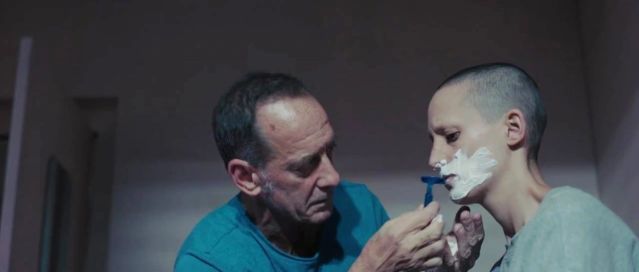Psychopathy
10 Films That Help Explain Female Psychopaths
A Personal Perspective: 10 films offer fresh takes on psychopathic manipulation.
Posted March 28, 2023 Reviewed by Devon Frye
Key points
- Female psychopathy may be more complex than research psychologists suggest.
- Ten recent films bring nuance to discussions about gender and psychopathy.
- Film can give viewers insight into what psychopathic manipulation feels like.
- The best films about psychopathy behave psychopathically towards viewers.
The best films about psychopaths, female or otherwise, behave like psychopaths—that is, they actively manipulate a viewer using film techniques that cause a viewer to feel betrayed.
A “psychopathic film,” I argue, uses film techniques like flashbacks, unreliable narrators, and mise-en-scene to give viewers a visceral experience of manipulation. These films titrate manageable feelings of betrayal for viewers so that they may recognize these feelings in the real world. When viewers know what manipulation feels like, they don’t need to rely on checklists, professional diagnoses, or gender differences to protect themselves from predacious people. (To read part 1 of this series, about gender differences in psychopathy, click here.)
Top 10 Female Psychopaths on Film
*Some spoilers ahead*
10. "Motherly" (Craig David Wallace, 2022)
This film is best left unspoiled. While imperfect in some ways, the film does offer a final act that upends viewers' expectations about who the real psychopath is in any given situation.

9. "The Stylist" (Jill Gevargizian, 2020)
Claire (Najarra Townsend) is an isolated hair stylist with a killer obsession. She uses her unique skills to scalp unwitting clients, later wearing their hair in front of a mirror to boost her low self-esteem.
Claire’s psychopathy is sympathetic: she’s socially awkward, desperately lonely, and eager for belonging. Her sexuality is almost non-existent. Instead, Claire craves an idealized romantic or friendship connection in a way that aligns with recent scholarship on female psychopathy. Claire may not break the “female psychopath” mold, but she’s a memorable representative example nonetheless.

8. "Sissy" (Hannah Barlow and Kane Senes, 2022)
"Sissy" is a film that will keep viewers guessing throughout its runtime. Aisha Dee’s hilarious and heartfelt portrayal of a Black wellness influencer plagued by recognizable struggles like imposter syndrome and social anxiety initially invites viewers into Sissy’s point of view. We see Sissy as a victim because Sissy sees herself as one—until, that is, she reconnects with a childhood friend.
Her friend invites Sissy to her engagement party, along with a hostile friend group filled with queers, disabled folks, and people of color, when things go awry. This film more than any other on this list takes great pleasure in challenging viewers’ expectations about wellness, race, gender, sexuality, and ability, speaking directly to the issues of our time.

7. "What Keeps You Alive" (Colin Minihan, 2018)
In a classic horror set-up, wives Jules (Brittany Allen) and Jackie (Hannah Emily Anderson) spend their wedding anniversary in a remote cabin in the woods. When Jackie’s childhood friend shows up unannounced, Jules finds herself worried about how little she seems to know about her wife. Little white lies start adding up, and soon Jules discovers the truth.
Jackie’s character is a poster child for the argument that psychopaths are born, not made. Jackie even says that it's “nature, not nurture” that she behaves in such callous, violent ways. After capturing her recently escaped wife, Jackie holds Jules’ fingers to her pulse. She demands Jules count her heartbeats. Jules, drenched in sweat, tears, and blood, cries and pants as she realizes Jackie’s heartbeat is steady.
Jackie is teaching Jules (and the audience) that typical fight-or-flight responses for organisms in life-or-death scenarios can’t touch a psychopath’s nervous system. Jackie isn’t coded as psychopathic because she has unstable emotions, high anxiety, or covert forms of aggression, as research psychologists would suggest. Instead, it’s her biology that’s psychopathic.
This film could have done more to explore the psychological and emotional manipulation that typifies psychopathy rather than relying on biology alone to account for psychopathic behavior. That said, it’s a nice surprise that Jackie’s queerness has nothing to do with her psychopathy.

6. "Speak No Evil" (Christian Tafdrup, 2022)
I would categorize "Speak No Evil" as “hard to watch.” The film follows a Danish couple who visits a Dutch couple they met on vacation. What follows is a black social satire about the ways face-saving social niceties can keep people trapped within the snares of psychopaths all too willing to exploit people’s inability to say “no” for fear of social rejection.
In many films with murderous couples, the male character is usually portrayed as the “true” psychopath while the woman is cast as a brainwashed victim. Here, however, the psychopathic characters are on equal footing. Take caution when watching: This film is mean (and eminently watchable).

5. "M3GAN" (Gerard Johnstone, 2023)
"M3GAN" was a late entry to this list, mostly because the psychopath under consideration was neither male nor female, but silicon.
The black horror comedy—and queer cultural sensation—follows a family beset by grief. A young girl loses both her parents in a car crash. Her workaholic aunt takes her in but, distracted by the demands of her job, doesn’t have the maternal skills required to help her niece heal. The aunt creates M3GAN, an AI robot toy, to protect her niece’s physical and emotional health. M3GAN takes this directive seriously, with deadly consequences.
What elevates "M3GAN" from camp to horror is the doll’s desire to manipulate her victims before death. Before a kill, M3GAN gives dispassionate evaluations of her victims that are a hallmark of psychopathic manipulation. She destroys her victims emotionally before the final visceral kill.

4. "Titane" (Julia Ducournau, 2021)
This French language film from Julia Ducournau still has me scratching my head. The striking use of mise-en-scene, lighting, and dream-like sequences create a hallucinogenic atmosphere as viewers follow the exploits of a murderous psychopathic woman who enjoys having sex with muscle cars.
Agathe Rousselle plays Alexia, a woman who goes on the run after a murder spree puts her in the crosshairs of law enforcement. To escape, she transforms her appearance to look like a young boy that went missing a decade earlier.
This gender swap is less about Alexia dismantling gender norms by living life as a man and more about how she views her body as a hunk of matter that must be molded like clay. She tapes down her breasts, bloodies and breaks her nose, and hides her pregnancy belly to survive, not to say anything political about how gender is a social construct. Her psychopathy overrides her gender at every stage.

3. "Pearl" (Ti West, 2022)
There’s a final scene in the film where Pearl (played by the ferocious Mia Goth, who co-wrote the film) stares directly into the camera. We’ve seen her commit atrocities for the past two hours, yet Goth’s emotional range compels us to feel sympathy and understanding for Pearl’s actions.
The scene is a long take. Goth’s face transforms into several deranged expressions that almost look human. I read this final scene as a beautiful articulation of the psychopathic “mask,” that is, the image psychopaths present to those in their orbit.
What Goth so powerfully shows is that a psychopathic individual is a chameleon in social situations. If a neighbor wants to believe she’s a helpless victim, that’s the role Pearl plays. If a love interest sees her as an innocent lamb, that’s the role Pearl plays.
This final scene shows what happens when there’s no one left for Pearl to mimic. She’s a series of surface emotions that glide across her face but aren’t anchored to anything below.

2. "Possessor" (Brandon Cronenberg, 2020)
Brandon Cronenberg’s "Possessor" is challenging to summarize. The sci-fi film uses hallucinatory sequences to depict how assassins in an alternate reality hijack the body of an unsuspecting victim to cause that person to murder a target.
Andrea Riseborough’s performance as assassin Tasya Vos is decidedly un-gendered. She’s numb, save for opportunities to kill. Her boss, played by Jennifer Jason Leigh, has her own brand of psychopathy that makes for a compelling duo.
The most striking aspects of this film occur when Vos is inside the head of one of her victims, played by Christopher Abbot. The scene captures what happens when a psychopath attempts to hijack a person’s sense of self. Sound distorts, colors blur, and bodies enmesh within one another such that easy distinctions between Vos and her victim become indiscernible. Vos even dons a grotesque mask that looks like skin melting off her face.
The disquieting imagery and silent dance between these two characters get at something about psychopathic manipulation that’s difficult, if not impossible, to put into words. The dream-like logic of this scene provides affect rather than rationale. Viewers feel discomfort, confusion, and disorientation in our attempts to understand what’s happening. Like Vos’ victim, we end up succumbing to dissociation and defeat.

1. "Soft & Quiet" (Beth de Araújo, 2022)
"Soft & Quiet" played on my expectations about white women to such a degree that my mouth was on the floor for most of it. Unlike "Titane" or "Possessor," this film is firmly grounded within the reality of everyday life in the U.S. The editing makes it feel as though it was shot in one long take, giving it an urgent, real-time quality.
The film highlights how white women enact white supremacy with just as much ferocity and vitriol as any other gender, albeit with a twist.
The film begins with women gathering for a female empowerment group for overworked suburban women looking to find connection outside their roles as wives, mothers, and teachers. They use language from feminism to articulate the ways suburban norms isolate women from support, leading to low self-worth and self-efficacy. The gonzo violence that follows is shocking given how these women use their whiteness and femininity as a smokescreen for their racist agenda.
What’s more, the film gives the viewer insight into the difference between strictly narcissistic characters and psychopathic characters. A narcissistic character, for instance, initially takes on a leadership role in the group. Viewers are led to believe she’ll be the most violent when given the chance. Viewer expectations are upset, however, once the violence reaches a fever pitch. Suddenly the narcissistic leader dissolves into a small child. She begins to dissociate. Shaky camera movements, sound distortions, and strange camera angles work to capture her disorientation.
A psychopathic character, on the other hand, is initially introduced as less put together than the leader of the group. But once in the throes of violence, she’s enthralled. The camera keeps focus on her without distortion, suggesting this character doesn’t want or need to dissociate from the violent spectacle. This quality of presence while enacting horrific violence, to me, differentiates a person with narcissism from one with psychopathy.
Final Words
These films ask viewers to look beneath surface appearances of how someone presents to reflect on what they feel when in the presence of a predator. Personally, the moment I begin to feel chronic confusion, dissociation, nausea, shock, or betrayal, I know it’s time to walk away, gender be damned.




